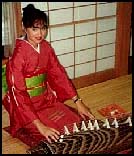

The KOTO is a thirteen-stringed zither with a harp-like sound made of a hollow piece of paulownia wood measuring about 180 centimeters (71") in length. The strings are plucked with ivory plectrums called o-tsume which are worn on the thumb, index, and middle fingers of the right hand. The strings are made of tetlon (originally silk) and are stretched over notched, moveable bridges called ji, enabling the player to tune to any eastern or western scale. The bridges were once made of ivory or rosewood, but today are made of durable plastic.
 The instrument originated in China and was brought to Japan around the
7th century and used as a court instrument until the late 12th century.
After the decline of court life, it was played by priests and
noblemen. During the 17th century, Yatsuhashi Kengyo (1614-1685)
began to play koto music outside its formerly restricted audience.
Called the "Father or Modern Koto," he invented new tunings and
composed many pieces for the koto including Rokudan, the most
well-known and often played classical koto piece to this day. By the
end of the 17th century the instrument was introduced to a wider segment
of society, including blind musicians and women.
The instrument originated in China and was brought to Japan around the
7th century and used as a court instrument until the late 12th century.
After the decline of court life, it was played by priests and
noblemen. During the 17th century, Yatsuhashi Kengyo (1614-1685)
began to play koto music outside its formerly restricted audience.
Called the "Father or Modern Koto," he invented new tunings and
composed many pieces for the koto including Rokudan, the most
well-known and often played classical koto piece to this day. By the
end of the 17th century the instrument was introduced to a wider segment
of society, including blind musicians and women.
In the 20th century, Miyagi Michio (1894-1956) was the first composer to combine koto with western instruments and kept the tradition alive by performing in Japan and abroad during a time of immense cultural change in Japan. He composed hundreds of pieces, including Haru No Umi in 1929 which is still played annually in Japan to welcome the New Year. He also invented the 17-string bass koto and expanded the playing techniques for the instrument. Sawai Tadao (1937-1997) and other composers continued to expand the repertoire for koto.
The koto was brought to Hawaii over a hundred years ago by Japanese sugar plantation workers and continues to be taught and passed on to the next generation of players.
![]() Back to Home
Page
Back to Home
Page
Copyright © Ranga Pae - All rights reserved